Commissioned By
Additional Funding
Collaborators
Methodologies
Forums
Exhibitions
- Super Sight: A World Viewed Through Technology
- Forensic Architecture: Witnesses
- Designs for Different Futures at the Art Institute of Chicago
- Designs for Different Futures at the Walker Art Center
- Rencontres d’Aflam
- Forensic Architecture: True to Scale
- Under the Radar
- Designs for Different Futures at the Philadelphia Museum of Art
- Violence, Fast and Slow
- Art Encounters Biennial 2019
- Violence, Fast and Slow
- Vertiginous Data
- The Long Duration of a Split Second at Turner Prize 2018
- Counter Investigations
- Forensic Architecture: Hacia una Estética Investigativa
- Forensic Architecture: Towards an Investigative Aesthetics
Shortly before dawn on 18 January 2017, police raided the Bedouin village of Umm al-Hiran, in the northern Naqab/Negev desert. During the raid, two people were killed: a villager, Yaqub Musa Abu alQi’an, and a policeman, Erez Levi.
Israeli officials described the death of Levi as a ‘terror attack’, and suggested that Abu alQi’an was connected to the terror group ISIS. But local residents and activists told a different story: police had fired at Abu alQi’an without provocation.
Since 2017, Forensic Architecture (FA) has worked with a group of documentary photographers, Activestills, to examine these claims. Our work pitted us directly against Israeli politicians and police chiefs, and exposed inconsistencies in the official account of the event, as well as mishandling of evidence after the fact.
Our investigations to date have found that:
– Abu alQi’an was shot by police before his car accelerated into a crowd, contrary to the claims of senior Israeli police and politicians.
– Abu alQi’an’s headlights were turned on as he drove past police, again contrary to the suggestions of senior Israeli police and politicians.
– Police prevented activists and medics from accessing the area around Abu alQi’an while he was bleeding to death, potentially preventing vital life-saving treatment.
– After Abu alQi’an’s death, sponge bullets and pepper spray were used by police to target activists with cameras, in ways that clearly contradict the Israel Police’s own regulations.
– A senior Arab politician, MK Ayman Odeh, was injured by police, likely by sponge bullets, in a way which contradicts the same regulations.
– Police shared a partial and incomplete evidence file with lawyers representing residents of the village, and Ayman Odeh.
Our involvement in this case is ongoing. The timeline below is adapted from the material exhibited for the Turner Prize 2018, at London’s Tate Britain.
Dawn, 18 January 2017
Hundreds of Israeli police raid the village of Umm al-Hiran. The aim of the raid was to demolish a number of homes, part of an ongoing attempt by the Israeli state to evict Bedouin villages in the region, to make way for new community settlements for orthodox Jews.
Keren Manor, a member of Activestills, began filming the scene in Umm al-Hiran shortly after 5:00am on the morning of 18 January 2017. By the end of the raid, Manor has recorded ninety-five separate videos. We would later realise that those videos had captured vital pieces of evidence in relation to the death of Abu alQi’an.
Morning, 18 January 2017
Through social media, Israel’s police declare that the events of hours earlier a ‘terror attack’.
Shortly after, it emerges that Ayman Odeh, MP and leader of the coalition of Arab parties in the Israeli parliament (called the Knesset), had been injured by police during the same incident.
Rony Alsheikh, Israel’s Chief of Police later claims, without evidence, that Abu alQi’an ‘had links to Daesh/ISIS’.
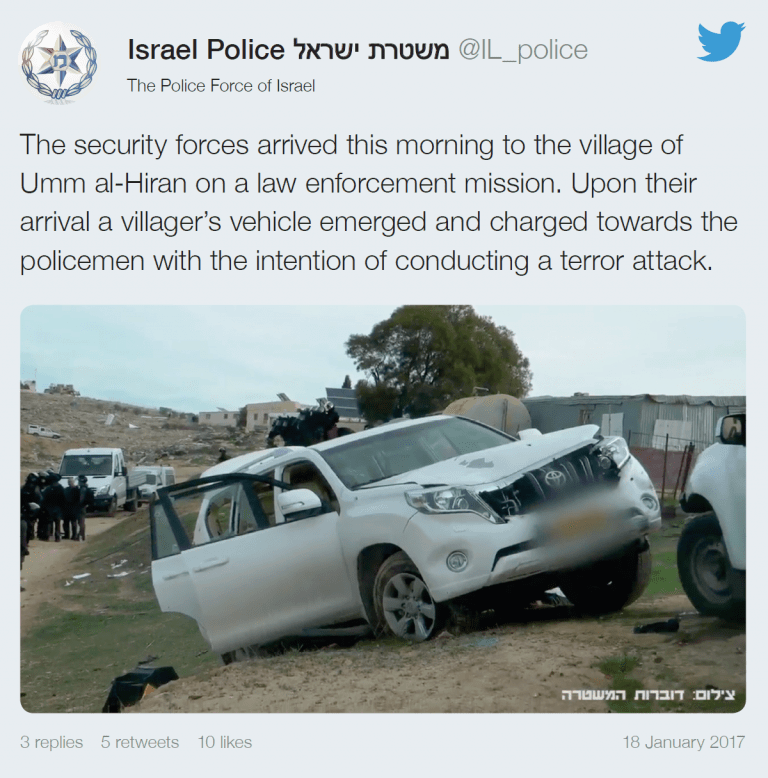
Midday, 18 January 2017
Israeli prime minister Benjamin Netanyahu sends condolences to the family of Erez Levi, and threatens retaliation against ‘those supporting and inciting terrorism’.
Gilad Erdan, Israel’s Minister for Public Security, accuses Abu alQi’an of murder, while claiming that Aymen Odeh and other Arab parliamentarians were responsible for encouraging the attack.

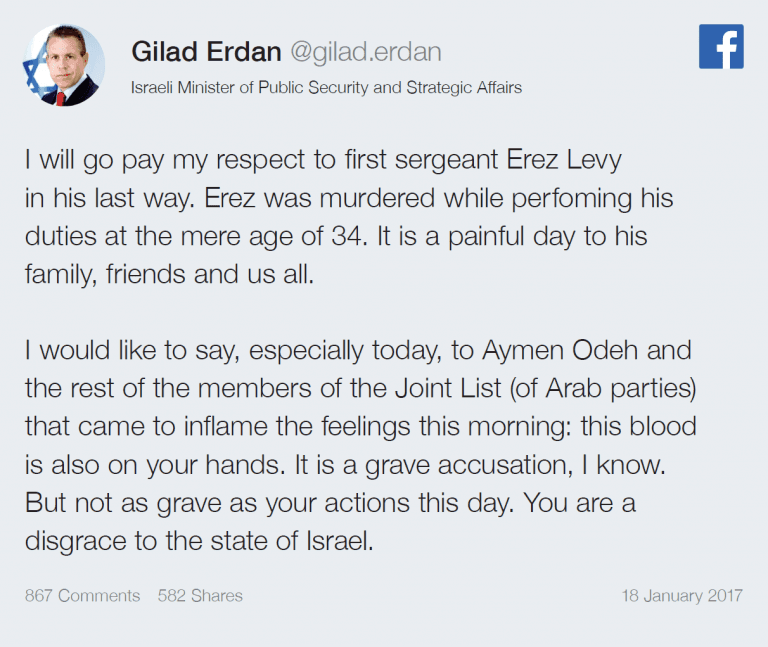
Afternoon, 18 January 2017
The Israel Police releases thermal imaging footage shot from a helicopter, which captures the morning’s incident.
They claim that the footage makes clear that Abu alQi’an’s intent was to kill.
On social media, police claim that in the video one can see ‘the terrorist’s vehicle standing by the road with its lights off’.
However, this not the kind of information that thermal imaging footage can capture.
Since thermal images only capture variations in temperature, and since a car turning on its headlights would cause only a very slight change in temperature, it is very unlikely a viewer would be able to tell from such footage whether a car’s headlights were on or off.
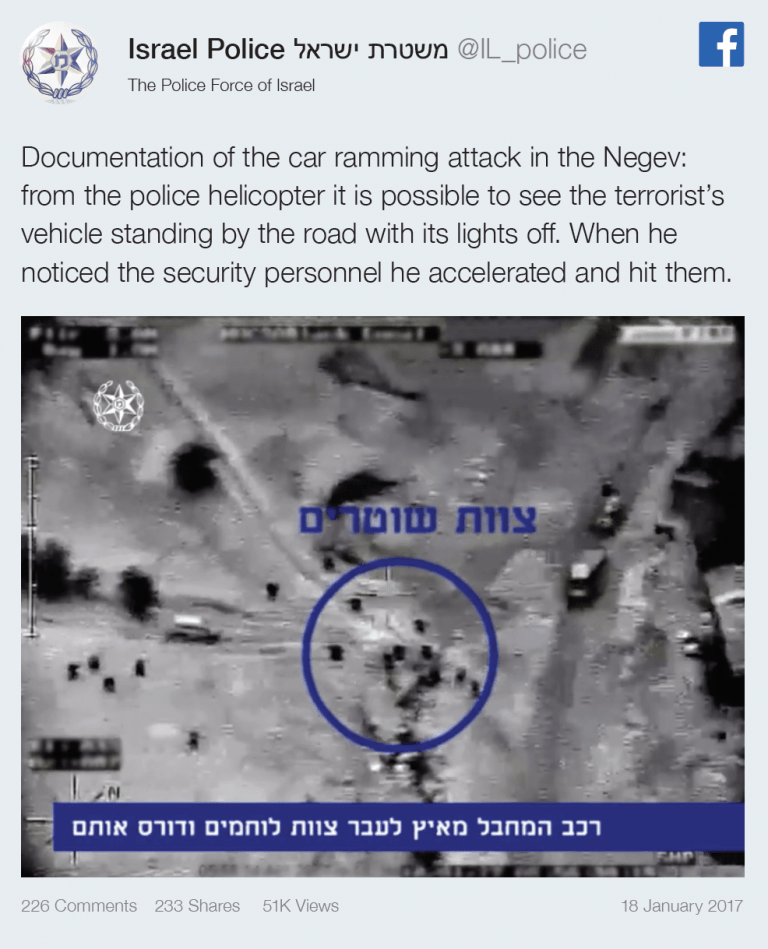
19 January 2017
FA undertakes a rapid and preliminary investigation, based on the thermal footage and a selection of footage captured on the ground.
Our results suggest that, contrary to the claims of Netanyahu, Erdan and others, police had fired at Abu alQi’an’s vehicle before it accelerated toward police.
The resulting video investigation, our first on the Umm al-Hiran case, is published by Israeli magazine +972.
When Ayman Odeh shares the investigation on Twitter the following day, the Israeli police respond.
Through that account, Israel’s police calls our investigation a ‘manipulative edit’, and says Abu alQi’an’s ‘intention to murder’ was clear.
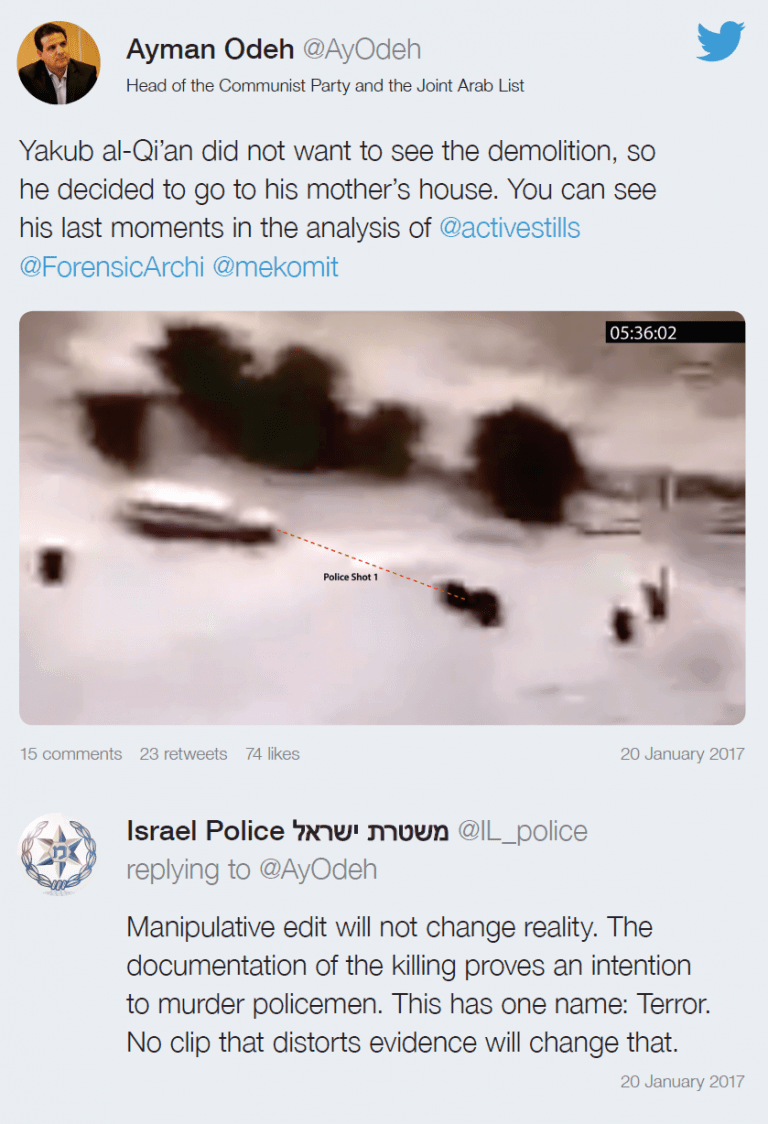
20–21 January 2017
The autopsy report conducted on the body of Abu alQi’an is leaked to the press.
The report shows that Abu alQi’an’s right knee was struck by a bullet, badly damaging it. It is possible that this injury caused Abu alQi’an to push on the accelerator pedal of his vehicle.
The report also suggests that Abu alQi’an was killed by a second bullet to the torso, and that his life could potentially have been saved if he had received medical attention.
In parliament, and in the media, Security Minister Erdan continues to insist that our investigation was biased, and that Abu alQi’an’s behaviour was consistent with a terrorist attack.
In particular, Erdan repeats the claim that Abu alQi’an was driving with his headlights switched off.
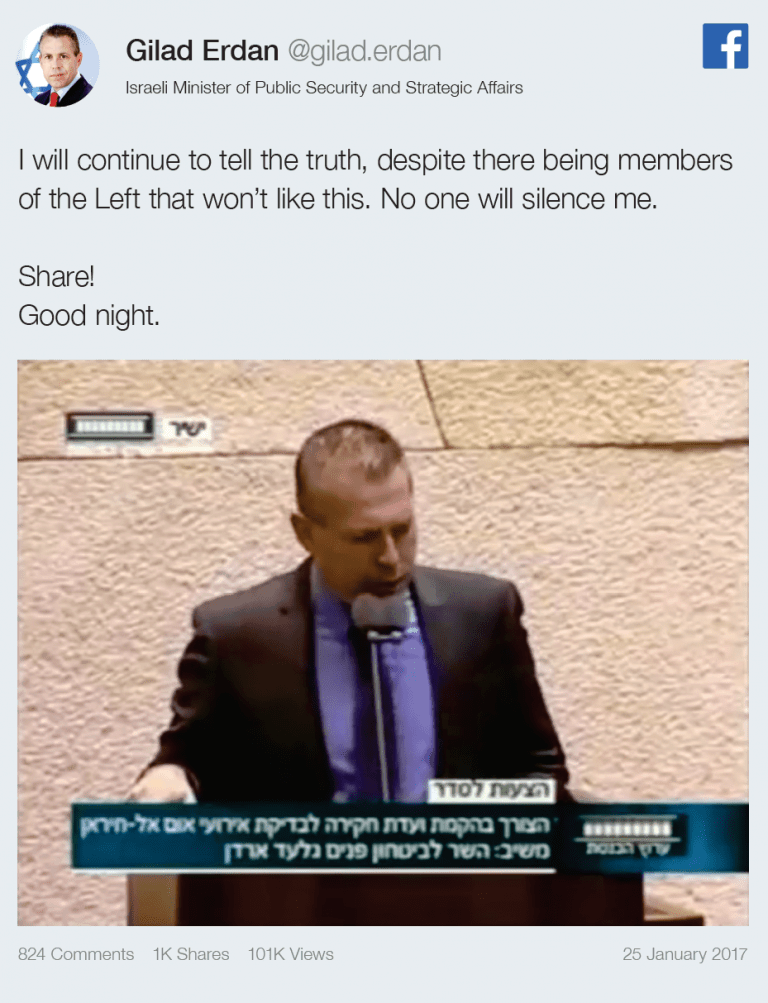
27 January 2017
Our researchers notice a detail previously overlooked, in a video of the incident broadcast by the Qatari news network Al Jazeera. Visible in the background of their footage is Abu alQi’an’s car—the headlights of the vehicle are clearly switched on.
1–3 February 2017
Our latest findings are again released through +972, and are subsequently covered by other media.
Odeh calls on Erdan and Chief of Police Rony Alsheikh to resign.
“..Almost every element of the story police relayed in the hours after the deadly incident has been repudiated…
Now, it seems the police claim that Yakub Musa Abu alQi’an was driving with his lights off, which allegedly made police suspect he was carrying out a vehicular attack, is most likely untrue as well… video shows Abu alQi’an’s vehicle, after three shots were fired at it, heading down a slope with its headlights on — before striking any police officers.”
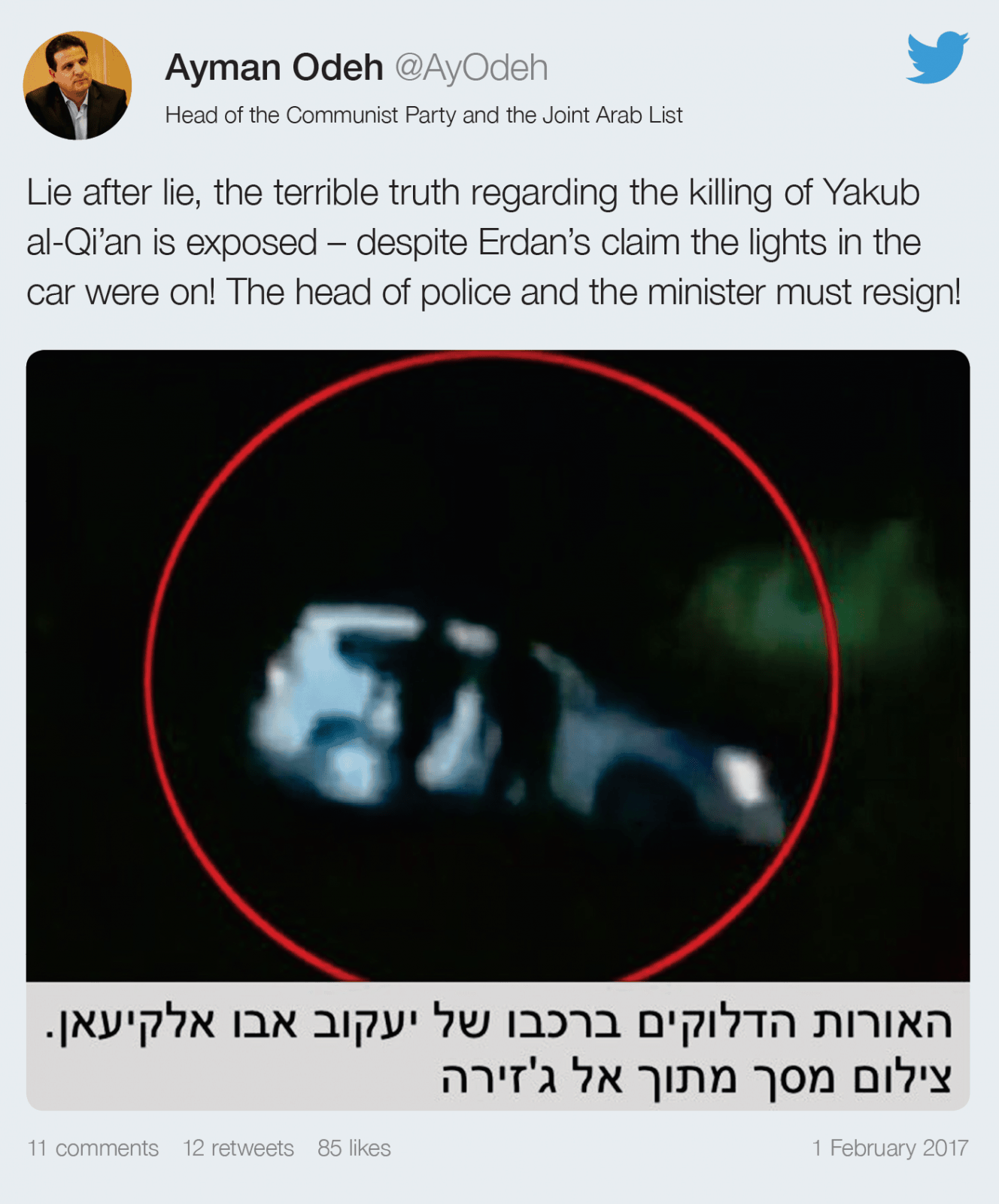
22 February–6 March 2017
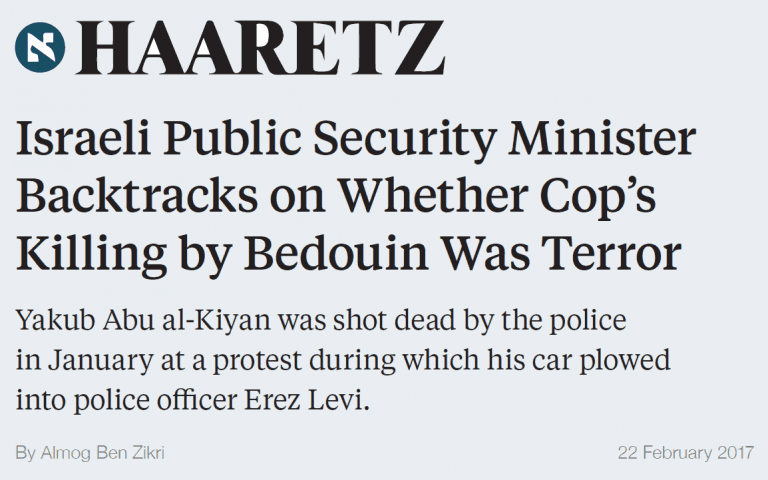
Erdan and others begin to retreat from their initial claims about Abu alQi’an’s actions and motives.
Speaking to a meeting of police, the Security Minister calls the deaths of Abu alQi’an and Levi ‘difficult and regrettable’, and suggests it is ‘possible’ he was mistaken in his initial assessment. (Erdan would later return to his original assessment of the situation.)
Agriculture Minister Uri Ariel apologises publicly, acknowledging that ‘there are voices attesting to grievous mistakes that were made’.
23 March 2017
Researchers from FA travel to Umm al-Hiran to undertake a reenactment of the events that led to Abu alQi’an’s death, on the very site at which those events originally unfolded.
Our experiments confirm that the topography of the area was such that Abu alQi’an need not even have pressed on the gas pedal for his car to have accelerated as it did.
12 June 2017
Further details of inconsistencies and procedural abnormalities in the investigation into Abu alQi’an’s death are reported in Israeli media.
Testimony given by the police physician on the scene contradicts that of the officers who approached Abu alQi’an’s car and claim they found him already dead. Reports also suggest that police officers were able to view contents of the internal investigation into the event before they had given their own testimony to investigators.
28 December 2017
The investigation into the policemen involved in the shooting is closed, and it is announced that no action will be taken against them.
The decision is not based on whether Abu alQi’an was indeed a terrorist, but whether police had grounds to perceive him to be one. The logic behind this decision is that of the ‘split second’: since security forces must make decisions and take actions on instinct, without the luxury of reflection, they cannot be held responsible for errors of judgement.
But instincts are a product of cultural conditioning, and the victims of police violence in Israel are disproportionately Arab citizens (just as in the US, they are disproportionately black). The logic of the split second thus condenses long histories of oppression, marginalisation and separation into a single moment.
12 April 2018
The community of residents of Umm al-Hiran announce the end of their struggle against eviction, agreeing to be relocated to one of the few approved Bedouin towns in Israel’s Southern District.
The decision marks the success of a fifteen year campaign by the Israeli state of legislative pressure, demolitions, and violence. The demolition of the village would commence just days later.
Ra’ed alQi’an, Yaqub’s nephew, says the killing of his uncle has broken the spirit of the residents, and that they intend to leave in order to avoid ‘further bloodshed’.
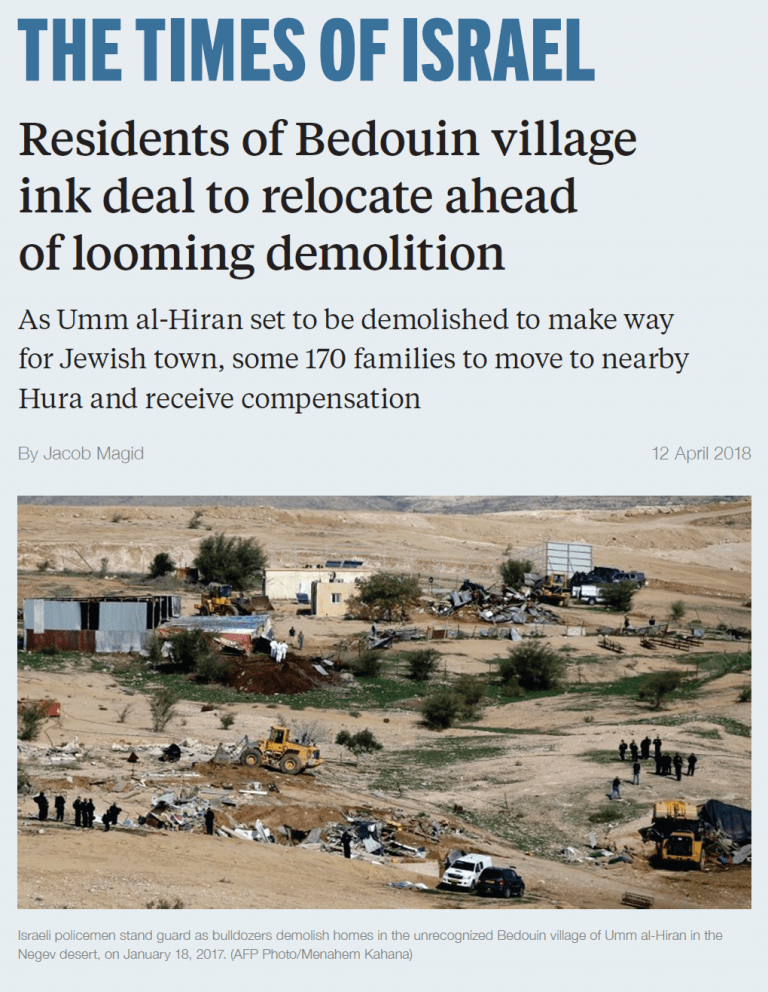
November 2018
Commissioned by Israel’s Public Committee Against Torture (PCATI), FA begins work on a new phase of the investigation, closely analysing the hours following the death of Abu alQi’an.
PCATI’s legal teams are representing former residents of Umm al-Hiran and Aymen Odeh in separate, ongoing petitions against the Israel Police.
As a result of these legal proceedings, PCATI receives a quantity of evidence from the police, including video and audio material, and documents, including police testimony. FA synchronises and arranges this video and audio material into a timeline, combining it with videos captured by activists and journalists. Once the relation between those videos in time is established, we track the movement of the actors – police, activists, and reporters – in digital space.
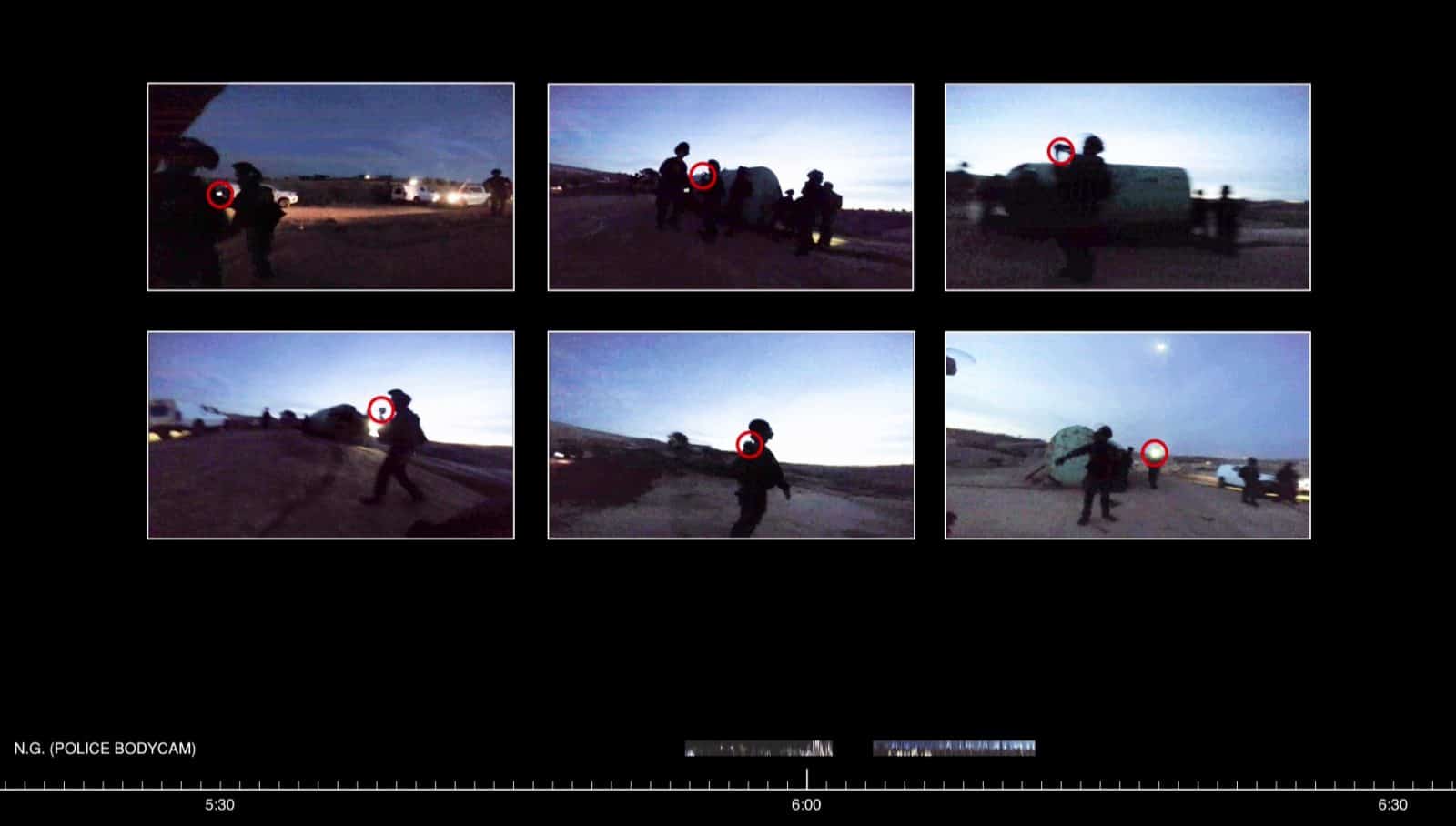
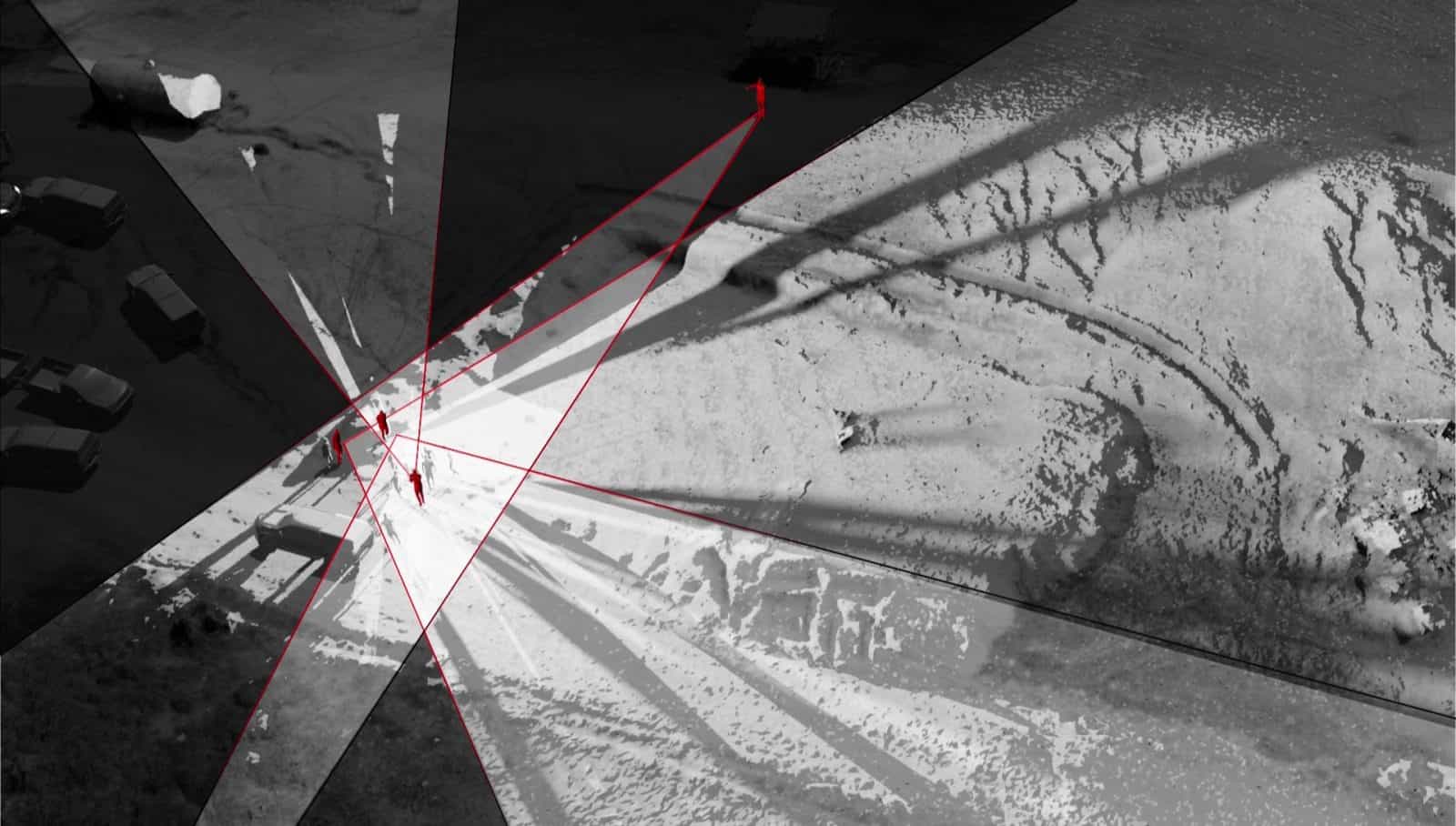
3 June 2019
The next stage of our investigation, based on PCATI’s evidence file, is published. Our results suggest that police acted illegally, committing violence against civilians, including Odeh. In some cases, police appeared to be preventing civilians from recording the event.
Our results also suggest that potentially vital evidence was missing from the case file supplied by the police to PCATI.
Previous edits
Our video investigations relating to the Umm al-Hiran case were updated for exhibition in 2018, following developments and newly available evidence in the case. Our original videos, published in the first half of 2017, are below.
Preliminary Findings, 19 January 2017. (Arabic/Hebrew)
Continued Investigation, 1 February 2017.
Umm al Hiran – Reenactment, 20 March 2017.
Arguing the Truth, 11 July 2017.